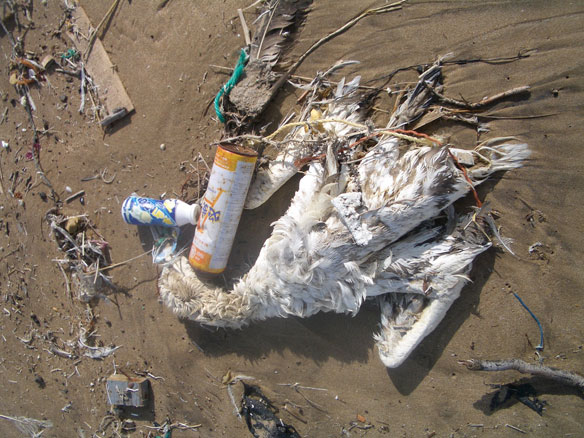
“When plastic ingestion occurs, it blocks the digestive tract, gets lodged in animals windpipes cutting airflow causing suffocation, or fills the stomach, resulting in malnutrition, starvation and potentially death.” Caption and Photo by: © SAF — Coastal Care.
Excerpts;
Prior research has suggested that mussels are a robust indicator of plastic debris and particles in marine environments. A new study says that’s not the case because mussels are picky eaters and have an inherent ability to choose and sort their food. Instead, the researchers have discovered that marine aggregates also called “marine snow,” play a much bigger role in the fate of the oceans when it comes to plastic debris.
More than 10 million tons of plastic debris enter the oceans every year and are found in nearly every oceanic layer. They start out as large floating items and eventually break down into much smaller pieces called microplastics. These particles are pervasive and have been found in the digestive tracts of more than 100 different species, posing physical, chemical and even potential biological harm to these animals. Mussels and other bivalves like oysters and clams are eaten whole without removal of the gastrointestinal tract and therefore represent a pathway for microplastics to enter the human food chain…
Read Full Article; Science Daily (10-23-2018)
Plastic pollution has increased a hundredfold in remote parts of the South Atlantic; Yale E360 (10-18-2018)
The amount of plastic debris in the ocean waters of the British islands in the South Atlantic — some of the most remote places on the planet — has increased hundredfold in the last 30 years, according to a new study…
Microplastics pollute most remote and uncharted areas of the ocean; Guardian UK (02-12-2018)
The Arctic is a ‘dead end’ for ocean plastic; MNN (04-24-2017)
Piling up: Drowning in a sea of plastic; CBS News (08-05-2018)
Piece by piece, an environmental threat is piling up, and we’re ALL to blame. Worse yet, even those of us trying to bring an end to the problem may not be doing as much good as we think…
These 10 companies are flooding the planet with throwaway plastic; Greenpeace (10-09-2018)
Nine months, six continents, 239 cleanup events, and more than 187,000 pieces of trash later, we now have the most comprehensive snapshot to date of how corporations are contributing to the global plastic pollution problem…
More Recycling Won’t Solve Plastic Pollution; Scientific American (07-06-2018)
More than 8. 3 billion tons of plastics made: Most has now been discarded; Science Daily (07-19-2017)
Humans have created 8.3 billion metric tons of plastics since large-scale production of the synthetic materials began in the early 1950s, and most of it now resides in landfills or the natural environment, according to a study.
Biodegradable plastic ‘false solution’ for ocean waste problem; Guardian UK (05-23-2016)
Video captures moment plastic enters food chain, BBC News (03-11-2017)
A scientist has filmed the moment plastic microfibre is ingested by plankton, illustrating how the material is affecting life beneath the waves. The footage shows one way that plastic waste could be entering the marine and global food chain…
New UN report finds marine debris harming more than 800 species, costing countries millions; United Nations (12-05-2016)
Marine debris is negatively affecting more than 800 animal species and causing serious losses to many countries’ economies, according to a United Nations report launched December 5th, 2016…
Plastic Pollution: “When The Mermaids Cry: The Great Plastic Tide,” Coastal Care
Plastic is versatile, lightweight, flexible, moisture resistant, strong, and relatively inexpensive. Those are the attractive qualities that lead us, around the world, to such a voracious appetite and over-consumption of plastic goods. However, durable and very slow to degrade, plastic materials that are used in the production of so many products all, ultimately, become waste with staying power. Our tremendous attraction to plastic, coupled with an undeniable behavioral propensity of increasingly over-consuming, discarding, littering and thus polluting, has become a combination of lethal nature…








